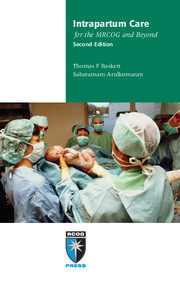Book contents
- Frontmatter
- Contents
- Preface
- Abbreviations
- 1 Improving intrapartum care
- 2 First stage of labour
- 3 Second stage of labour
- 4 Fetal surveillance in labour
- 5 Third stage of labour
- 6 Lower genital tract trauma
- 7 Induction of labour
- 8 Preterm labour and prelabour rupture of membranes
- 9 Assisted vaginal delivery
- 10 Shoulder dystocia
- 11 Breech vaginal delivery
- 12 Twin and triplet delivery
- 13 Caesarean section
- 14 Vaginal birth after caesarean section
- 15 Uterine rupture
- 16 Emergency obstetric hysterectomy
- 17 Cord prolapse
- 18 Antepartum haemorrhage
- 19 Postpartum haemorrhage
- 20 Acute uterine inversion
- 21 Amniotic fluid embolism
- 22 Disseminated intravascular coagulation
- 23 Acute tocolysis
- 24 Severe pre-eclampsia and eclampsia
- 25 Neonatal resuscitation
- 26 Perinatal loss: management of late fetal death and stillbirth
- Index
Preface
Published online by Cambridge University Press: 05 July 2014
- Frontmatter
- Contents
- Preface
- Abbreviations
- 1 Improving intrapartum care
- 2 First stage of labour
- 3 Second stage of labour
- 4 Fetal surveillance in labour
- 5 Third stage of labour
- 6 Lower genital tract trauma
- 7 Induction of labour
- 8 Preterm labour and prelabour rupture of membranes
- 9 Assisted vaginal delivery
- 10 Shoulder dystocia
- 11 Breech vaginal delivery
- 12 Twin and triplet delivery
- 13 Caesarean section
- 14 Vaginal birth after caesarean section
- 15 Uterine rupture
- 16 Emergency obstetric hysterectomy
- 17 Cord prolapse
- 18 Antepartum haemorrhage
- 19 Postpartum haemorrhage
- 20 Acute uterine inversion
- 21 Amniotic fluid embolism
- 22 Disseminated intravascular coagulation
- 23 Acute tocolysis
- 24 Severe pre-eclampsia and eclampsia
- 25 Neonatal resuscitation
- 26 Perinatal loss: management of late fetal death and stillbirth
- Index
Summary
While maternal and perinatal mortality rates are low in most developed countries, there remain a significant number of ideally preventable deaths in both categories. Furthermore, much of the focus of clinical services is now directed towards preventing the more common severe maternal and neonatal morbidities – the so-called ‘near miss’ category.
As most of the adverse outcomes are related to labour and delivery, the labour ward is the front line of these endeavours. Caring for women in childbirth is one of the most rewarding aspects of our specialty, but it comes with the need to make rapid decisions under duress and the increasing spectre of litigation. There is a fine clinical balance required from midwives and obstetricians to provide the vigilant care necessary to prevent and manage the relatively rare adverse events during labour, and yet support the wishes of the woman who wants minimal interference.
We have added six new chapters to this second edition of Intrapartum Care for the MRCOG and Beyond: improving intrapartum care, lower genital tract trauma, emergency obstetric hysterectomy, acute uterine inversion, disseminated intravascular coagulation and acute tocolysis. We feel that these topics have increasing importance and warrant separate consideration. Each chapter contains limited references, but readers are encouraged to consult the Pregnancy and Childbirth Module of the Cochrane Database of Systematic Reviews as well as national and College guidelines.
- Type
- Chapter
- Information
- Publisher: Cambridge University PressPrint publication year: 2011



